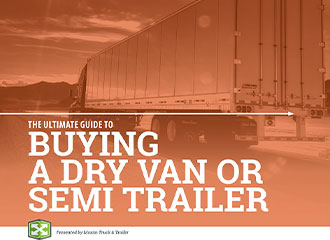11 Questions to Ask about Purchasing a Dry Van or Semi Trailer
 Scott Kinsman is the authority on Semi-Trailers at Maxim Truck & Trailer. When you've been in the industry as long as Scott, there isn't much he hasn't seen when it comes to what trucks tow.
Scott Kinsman is the authority on Semi-Trailers at Maxim Truck & Trailer. When you've been in the industry as long as Scott, there isn't much he hasn't seen when it comes to what trucks tow.When you’re putting an investment into transportation for your business, you need to have the information to be able to making the best one. With questions like, “new or used?”, “steel or aluminum wheels?”, and “barn or rollup doors?” that experience is pretty vital when you’re planning to purchase a trailer.
In the next 11 questions, Scott will use what he knows to try and make you a more informed semi-trailer purchaser, so you can make the best investment for your business.
VIEW MAXIM'S DRY VAN INVENTORY
| 1 | How many dry vans will do the job? One or two units should do the trick for a specific application or new contract. Or it could be 5, 10, 20, 50 or more as part of a fleet acquisition program for a large contract or replacement program. Dealers will stock some quantities of common dry vans but if the quantity gets over 10 or 20 units you will likely not find these quantities in stock. Lead times for new factory orders can range from a low of 3 months to a high of 9 months with 4 to 5 months being fairly typical. The lead time is driven by how much of a backlog the factory has along with lead times for components needed to build the trailer, such as suspensions. |
| 2 | What applications can a dry van be used for? Long haul freight, local P&D work, concentrated loads (ie. liquids) or other special applications that might require a specific type of trailer build or options such as lift gates, side doors, etc. |
| 3 | What is the length of a dry van? Dry vans can be built from 28’ to 57’ long and overall heights from 12’ 6” to 14’ are normal. Typical North American Highway dimensions limit the overall length to 53’ and the overall height to 13’ 6”. There are also drop floor vans which allow for significant increase in interior space. Drop vans are not normally used for typical dry freight applications. |
| 4 | How are dry vans manufactured? There are several methods by which dry vans can be built but there are basically two main types which are commonplace today. These two styles are called sheet and post construction and composite plate construction. Each style has advantages and disadvantages. The sheet and post style has been around for a very long time and consists of fastening vertical specially formed posts to a horizontal bottom rail then adding a sheet of metal over the posts to finish the construction of the walls. It is the most common and least expensive to repair. The composite plate style dry van first entered the market in 1996 with its walls constructed of galvanized steel sheets with plastic sandwiched in between. While the composite plate trailer is tougher to damage it is more expensive to repair. Composite plate trailer designs also offer the greatest interior width within a dry van but are also slightly heavier than sheet and post construction. |
| 5 | Does it matter what kind of doors I have? The rear doors can be either two side hinged doors that swing to the sides and are tied back against the side walls, generally called barn doors. Barn doors are by far the most typical style of rear door system on a dry van. The other style is a rollup door which is much like a typical garage door which opens upwards. The rollup doors are more commonly used with local P&D trailers and are necessary when a rail style lift gate is installed. It’s important to get the right type of rear opening for the type of deliveries you’re doing. If you’re using loading docks, there will be enough room for swing doors. But if you don’t have as much space, you’ll probably need a roll-up door. It’s all about knowing your business. |
| 6 | What about the roof? The roof is commonly made of a single sheet of aluminum which is installed under tension. The other option is a fiberglass roof sheet which is commonly called a translucent roof since it allows abundant ambient light into the trailer. While the translucent roof is great for forklift operators and drivers to see within the trailer, the fiberglass roof skin is easier to damage and more expensive to repair. A translucent roof may also be rejected by some shippers who have photosensitive loads. |
| 7 | And the floor? The floor of a dry van is commonly made of laminated hardwood although aluminum floors are available too. The laminated hardwood needs to be of excellent quality as it must keep moisture from intruding into the trailer while it is in transit. There are options for coating the top and bottom of the wood floor with coatings which will greatly enhance the longevity and strength of the floor. |
| 8 | Do suspensions vary between dry vans? Suspensions can range from single axle spring ride to tridem air rides or some other more elaborate setups to take advantage of regional permits or regulations to carry more weight. There are many options on how to specify the running gear of the trailer however tandem air ride is the majority. |
| 9 | What brakes do most dry vans have? The basic brakes are 16.5” by 7” cast steel drums with options for higher quality and lighter weight brake packages are available on special order along with air disc brake systems. Along with brakes the wheel hubs are also cast steel as standard with options for lightweight hubs of steel or aluminum are available along with the opportunity to special order parallel spindles instead of tapered spindles. While the parallel spindle system adds some weight to the trailer it is offset by being more robust and providing longer life for the bearings and seals with possibly some additional benefits to tire life. |
| 10 | What's the size of the rims and tires? Rims are standard as steel 8.25” by 22.5” duals and tires are low profile 22.5”. Regionally we see that different tire and even rim sizes are considered more common, such as 11R22.5”, low profile 24.5” or even 11R24.5” may be stocked on new equipment. There is also the option of going to a super single rim and tire package but these are not normally stocked. Aluminum rims are another item which is popular on custom orders as they save weight, reduce heat at the wheel ends and look great for long periods of time regardless of the conditions they are subjected to. |
| 11 | How can I protect my trailer from corrosion? Corrosion protection is built into standard dry van construction however there are options which can help provide greater corrosion protection. Such options include using stainless steel, galvanizing, elastopolymer coatings and other types of finishes. |







